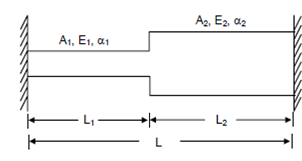Fully Restrained Stepped Bar:
Consider a bar of length L which has a uniform cross-sectional area A1 over length L1 although in the rest of the length L2 the cross-sectional area is A2. Let the Young's Modulus and the coefficient of linear expansion for the two parts be E1, α1 and E2, α2, correspondingly.
The ends of the bar are fully restrained. The bar is display in Figure. Let the temperature of the bar be raised through ΔT.

Figure
If the bar were free to expand, it would have extended by a length ΔL given by
ΔL = L1 α1 ΔT + L2 α2 ΔT
= (L1 α1 + L2 α2) ΔT
Because the bar is fully restrained, P, the compressive force developed would have to produce a contraction equal to ΔL. Let this force generates a stress σ1 in part 1 and σ2 in part 2 (these are the thermal stresses).
σ1 = P/A1 , σ2 = P/A2
σ1A1 = σ2A2 or σ2 =A1/A2 × σ1
σ1 will produce a strain equal to σ1/E1 and a change in length ΔL1 equal to σ1 L1/E1
Similarly, σ2 will produce a change in length ΔL2 equal to σ2 L2/E2. Thus, the total change in length due to the application of force P will be equal to (ΔL1 + ΔL2),
We get, ΔL1 + ΔL2 = σ1 L1/E1 + σ2 L2/E2
But this should be equal to ΔL.
Therefore, σ1L1/E1 + σ2L2/E2 = ΔL =( L1 α1 + L2 α2) ΔT
σ2 = A1/A2 σ1
= ΔL = (L1 α1 + L2 α2) ΔT
∴ σ = (L1/E1 +L2A1/A2E2) = ΔT (L1 α1 +L2 α2)
Hence ∴ σ1 = ΔT E1 E2 A2 (L1 α1 +L2 α2)/(A1E1L2 +A2E2L1), and
∴ σ2 = ΔT E1 E2 A1 (L1 α1 +L2 α2)/(A1E1L2 +A2E2L1).